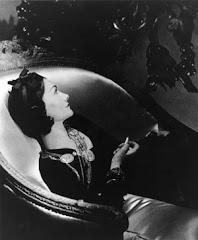Quite coincidentally, a person called L. Grant of London asks Hadley why she can't find an evening dress with sleeves. It can't be me because I would never use the word 'lady' and Hadley would never edit down and rewrite a flawlessly worded query by a Booker shortlistee:
To paraphrase Kanye West's "George Bush doesn't care about black people" remark - albeit with more of an emphasis on frocks than housing - designers don't care about grown women.Which is kinda odd, seeing as they tend to make up the majority of their customer base, given that it is a rare twentysomething who can afford to spend £800 on a dress for a night out with the girls. But, you see, older people don't model in the shows, and older people don't model in magazines and, perhaps most importantly, the only examples of older women many designers seem to be aware of are, in this order of importance, brittle fashion magazine editors, suspiciously well-preserved fortysomething actors and skeletal society mavens. These women tend to have twiggish upper arms which they are rather fond of showing off, if only to demonstrate to the masses that a life of sensory deprivation really does get you somewhere: to a place where smiling is no longer possible but short sleeves are. Now, there's a life well lived, I'd say.
The fashion industry, like many creative industries, has become so besotted by celebrity and magazine coverage that it occasionally forgets about those pesky little flies, "the customers". Yah, yah, let them eat cake, right? (And they probably actually do eat cake, those repulsive carb-gobbling fatties.)
Part of the problem comes from the dresses. A long-sleeved dress can make a lady look like the spells mistress at Hogwarts or, on a bad day, the Wicked Witch of the West. But this is why we have people called "designers", who are there to make clothes look nicer than we could ourselves. Which then brings us back to the original problem.

4 comments:
Love your introduction to this post. I wonder how much more expensive dresses will be with the added metre of fabric for sleeves . . .
Have you seen Plum Sykes' piece on sleeves in the latest (American) Vogue? Rather convincing on their value, even for 30-ish women. But as Greying Pixie did here earlier in this discussion, Sykes comments on the challenges of a well-cut sleeve set into the narrow armhole that flattery demands. She suggests this may be one reason sleeves aren't getting done enough. And, as Miss C. wonders, there's the cost of the sleeve fabric. We'll pay, people, we'll pay -- finally, we've got a bit of money and we'd love flattering garments -- we'll pay!
Hear, hear!
I'm also surprised, living in America right now, that there's no high fashion designer who specializes in plus-sizes here. There's an enormous market of fashion-conscious women with money to spend, who can't find a single designer garment that fits them. I suspect that's part of the reason for the huge success of designer bags and shoes; they're the only thing in the designers' collections that most of us can fit into.
At a US size 8 (about an English 12 I think?) I'm significantly smaller than average, and nobody here would exactly call me fat -- and yet, many hot designers don't make anything I could fit into. How bad must it be for women who are average-sized, or even above-average?
If the complaints I hear from curvaceous friends are anything to go by, it's very hard for them.
Some of the sexiest women I know are plus-size, whereas the "social X-rays" here in NYC usually look underfed and unhappy -- not a good look.
So when a hot new designer does buck the trend and do clothes for red-hot hourglass curves, it will be huge.
Linda, have you seen the photos of Emma Thompson at the Brideshead Revisted premiere? She has solved her sleeves problem by wearing a Donna Karan silk coat as a dress.
Post a Comment